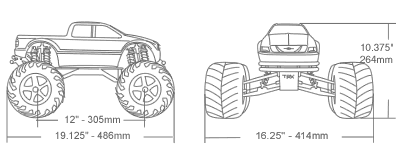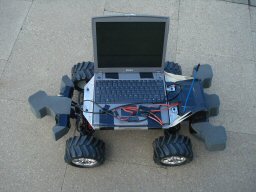|
DIPLECS
RC Car
History
 As
part of the EU Project DIPLECS, one
of our demonstration platforms is a small RC car/mobile platform. We had
previous used an RC car (in COSPAL) as a mobile platform mounted with a
small wireless camera. Images were transmitted back to a central
computer which processed the images and controlled the car via a USB
connection to the buddy port on the RC transmitter. This was achieved
using an interface from Tom’s RC,
original developed for interfacing RC transmitters to flight simulators.
This system had
many problems: As
part of the EU Project DIPLECS, one
of our demonstration platforms is a small RC car/mobile platform. We had
previous used an RC car (in COSPAL) as a mobile platform mounted with a
small wireless camera. Images were transmitted back to a central
computer which processed the images and controlled the car via a USB
connection to the buddy port on the RC transmitter. This was achieved
using an interface from Tom’s RC,
original developed for interfacing RC transmitters to flight simulators.
This system had
many problems:
- The
various components and associated power requirements (i.e.
batteries).
- The
terrible video feed quality (low power transmitter makes it prone to
interference and occlusion).
- RC
controller inoperable during buddy mode meaning control was via
keyboard mouse or joystick.
To make things easier we used a gaming style ‘steering
wheel’ to generate the control signals to send to the transmitter.
This made control easier but the system was difficult to capture data
with and had very little mobility, meaning, out door use was not
feasible.
 Shortly
afterwards, we started the SEP
project and a small team of undergraduates built two mobile platforms
based on a 4WD3
low end robotics platform from Lynxmotion
that carried a laptop. The platform carried a custom frame on which was
mounted a camera, ultrasound detectors and a motor controller all
connected via a PIC microcontroller to the USB port of the laptop.
Having reasonable processing on board was a huge advantage for
autonomous control. The ability to connect seamlessly with a network of
additional processors using wireless meant that processing could be
deployed over various machines. This was facilitated using a generic
peer-to-peer networking API. However, the platform was quite slow (2-4
miles per hour), cannot carry much weight and has no direct interface
other than via the onboard keyboard or laptop via the network. Shortly
afterwards, we started the SEP
project and a small team of undergraduates built two mobile platforms
based on a 4WD3
low end robotics platform from Lynxmotion
that carried a laptop. The platform carried a custom frame on which was
mounted a camera, ultrasound detectors and a motor controller all
connected via a PIC microcontroller to the USB port of the laptop.
Having reasonable processing on board was a huge advantage for
autonomous control. The ability to connect seamlessly with a network of
additional processors using wireless meant that processing could be
deployed over various machines. This was facilitated using a generic
peer-to-peer networking API. However, the platform was quite slow (2-4
miles per hour), cannot carry much weight and has no direct interface
other than via the onboard keyboard or laptop via the network.
The New Platform
For the DIPLECS demonstrator car we have combined the best of both
worlds. The DIPLECS car is based upon an
TRAXXAS E-MAX RC car. The advantages being:
- Low
cost consumer electronics (£250).
- Four
wheel drive.
- Powerful
and very fast (30+mph).
- Configurable
gearing and suspension.
The E-Max is a 1/10 scale, 4 wheel drive, electric RC
monster truck with dual 14V 550 electric motors, 4 inches of ground
clearance, 8 oil filled shock absorbers and can achieve 30+mph.
 The stripped E-MAX
carries an aluminum platform on which a laptop can be strapped and a
box that contains the interface. The stripped E-MAX
carries an aluminum platform on which a laptop can be strapped and a
box that contains the interface.
 The
interface box contains a 40MHz receiver which connects directly to a
MFTech
USB-Interface II which allows the PWM signals to be read directly on the
computer where they can be logged. A 2nd USB interface from Pololu,
capable of controlling up to 16 servos, then reproduces the PWM signal
when instructed. This connects directly to the servos and motor
controller. The box of electronics contains a small USB hub, the MFTech
and Pololu interfaces, RC receiver/arial, Bluetooth adapter and GPS receiver.
The control box connects to the laptop is via single USB cable and
connects to the servos and motor controller via standard . During normal driving the onboard laptop simply reads the
incoming PWM signal and reproduces this directly on the output allowing
the platform to be controlled via a standard RC transmitter. However,
while this is done it can be logged to memory or stored to disk along
with any sensors or camera data that is required.
During autonomous operation the onboard laptop can directly
generate PWM signals to control the platform, however, it can continue
to monitor the input channels from the receiver providing a wireless
"dead man's" switch allowing the operator to terminate or take
over control of the platform at any time. The
interface box contains a 40MHz receiver which connects directly to a
MFTech
USB-Interface II which allows the PWM signals to be read directly on the
computer where they can be logged. A 2nd USB interface from Pololu,
capable of controlling up to 16 servos, then reproduces the PWM signal
when instructed. This connects directly to the servos and motor
controller. The box of electronics contains a small USB hub, the MFTech
and Pololu interfaces, RC receiver/arial, Bluetooth adapter and GPS receiver.
The control box connects to the laptop is via single USB cable and
connects to the servos and motor controller via standard . During normal driving the onboard laptop simply reads the
incoming PWM signal and reproduces this directly on the output allowing
the platform to be controlled via a standard RC transmitter. However,
while this is done it can be logged to memory or stored to disk along
with any sensors or camera data that is required.
During autonomous operation the onboard laptop can directly
generate PWM signals to control the platform, however, it can continue
to monitor the input channels from the receiver providing a wireless
"dead man's" switch allowing the operator to terminate or take
over control of the platform at any time.
Adam,
a very able Nuffield student, came back to do some work on the car for
us and wrote the software library to handle the communication with the
interfaces.
Shocks have been upgraded to cope with the additional
weight of onboard electronics and both electronics and laptop are
mounted on a custom aluminum platform that attaches directly to the
E-MAX chassis. The ludicrous foam at the front and rear was a direct
result of our first test run which resulted in a high speed crash into a
brick wall damaging the rear shock absorbers when the control box was
driven into them. This is an interim measure and we expect the appearance
to change considerable over time as we add new components and change the
onboard processing. The "successful" 2nd test 2 days later
when the shocks had been replaced can be seen here.
Richard Bowden
CVSSP, EPS
University
of
Surrey
Guildford,
Surrey
GU2 7XH
,
UK
+44(0)1483 689838
r.bowden@surrey.ac.uk
|
 As
part of the EU Project
As
part of the EU Project  Shortly
afterwards, we started the
Shortly
afterwards, we started the 
